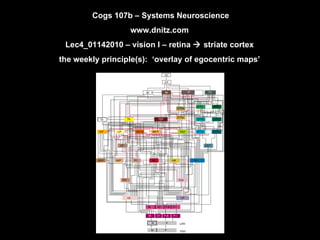
Retina to Primary Visual Cortex Mapping
- 1. Cogs 107b – Systems Neuroscience www.dnitz.com Lec4_01142010 – vision I – retina striate cortex the weekly principle(s): ‘overlay of egocentric maps’
- 2. left and middle panels: cerebral cortex is a six-layered structure the dendrites of neurons in each layer may be restricted to that layer or extend across many layers right panel: axons of neurons from a given layer may extend horizontally (e.g., layer 1) or vertically (e.g., layer 4) horizontal extensions connect different sub-regions of cortex while vertical extensions form localized circuits basic structure of the human cerebral cortex
- 3. “ These data . . . support an hypothesis of the functional organization of this cortical area. This is that the neurons which lie in narrow vertical columns, or cylinders, extending from layer II through layer VI make up an elementary unit of organization, for they are activated by stimulation of the same single class of peripheral receptors, from almost identical peripheral receptive fields, at latencies which are not significantly different for the cells of the various layers.” Vernon Mountcastle
- 4. the primary visual cortex (area 17 / V1) cortical column
- 5. cortical columns across the street (i.e., at the Salk / Callaway-lab)
- 7. low light = rods (cones unresponsive) medium light (moonlight) = rods and cones bright light = cones (rods saturate)
- 8. photoreceptors release glutamate in darkness and exhibit graded hyperpolarizations in response to different luminance levels hyperpolarization of photoreceptors results in decreased glutamate release
- 9. there is a basic connectivity pattern of the retina: photoreceptor bipolar cell ganglion brain but….. - bipolar cells can be excited or inhibited by photoreceptors and interneurons (amacrine and horizontal cells) modify ganglion cell response to bipolar cells - ganglion cells are of 3 types (parvocellular-X, magnocellular-Y, and koniocellular
- 10. bipolar cells of the retina: mechanisms for ‘on’ and ‘off’ responses ‘ ON’ bipolars – ‘activation’ (depolarization) in response to light – these cells are hyperpolarized in response to the neurotransmitter glutamate – light causes photoreceptors to hyperpolarize and release less glutamate – the reduced glutamate release onto the ON-bipolar is, effectively, the removal of an inhibitory (hyperpolarizing) influence – as a result, the bipolar cell depolarizes ‘OFF’ bipolar ‘ON’ bipolar 0 mV -40 mV 0 mV -40 mV light on light on ‘ OFF’ bipolars – ‘inactivation’ (hyperpolarization) in response to light – these cells are depolarized in response to the neurotransmitter glutamate – light causes photoreceptors to hyperpolarize and release less glutamate – the reduced glutamate release onto the OFF-bipolar is, effectively, the removal of an excitatory (depolarizing) influence – as a result, the bipolar cell hyperpolarizes Note: bipolar cells exhibit graded electrical potentials (i.e., not action potentials) – like hair cells of the vestibular system, they release neurotransmitter (glutamate) in proportion to the level of depolarization as opposed to the rate of action potentials
- 11. 0 mV -40 mV light on LGN ‘OFF’ bipolar (glutamate depolarizes) 0 mV -40 mV light on photoreceptor 0 mV -40 mV light on ‘ON’ ganglion ‘OFF’ ganglion light on light on ‘ on’ and ‘off’ bipolar cells ‘on’ and ‘off’ ganglion cells I – a light spot in an otherwise dark field ‘ON’ bipolar (glutamate hyperpolarizes)
- 12. 0 mV -40 mV light off LGN 0 mV -40 mV light off photoreceptor 0 mV -40 mV light off ‘ON’ ganglion ‘OFF’ ganglion light off light off ‘ on’ and ‘off’ bipolar cells ‘on’ and ‘off’ ganglion cells II - a dark spot in an otherwise illuminated field ‘OFF’ bipolar (glutamate depolarizes) ‘ON’ bipolar (glutamate hyperpolarizes)
- 13. firing rate - Hz (action potentials / second) 0 40 0 40 0 40 0 40 light on light on X-’on’, X-’off’, Y-’on’, and Y-’off’ ganglion cells
- 14. ‘ on’ and ‘off’ ganglion cells: surround inhibition & surround excitation
- 15. ganglion cell output of the retina: division into three main classes property parvocellular-(X) magnocellular-(Y) koniocellular surround inhibition yes yes no (luminance opponency) color opponency yes no yes receptive field size / resolution small / high large / low ? response to light sustained transient ? low-contrast, moving stimuli weak response strong response ? percent of ganglion cell population ~80% ~10% ~10%
- 17. parvocellular layers magnocellular layers koniocellular layers the LGN: layering corresponds to type of ganglion cell and left vs. right eye
- 18. LGN – koniocellular output LGN – parvocellular output LGN – magnocellular output LGN – koniocellular output output of cortical column primary visual cortex (striate cortex area V1) – integration of pathways from the LGN
- 19. overlay of egocentric maps in V1 - the first map – retinotopic L-hemisphere (side-on view) field of view (center = foveal focal point) frontal cortex temporal cortex occipital cortex R-hemisphere (side-on view) frontal cortex temporal cortex occipital cortex THE MAPPING OF THE FIELD OF VIEW ONTO THE RETINA IS AN EXAMPLE OF A TOPOGRAPHIC REPRESENTATION: the left visual field light is represented (excites V1 neurons) in the right striate/V1 cortex (and vice versa) – the upper half of the visual field is represented in the bottom half of V1 (and vice versa) – light hitting the retina close to the fovea excites neurons in the central lateral region of V1 (light hitting the outer edge of the retina excites neurons in the central medial region of V1)
- 20. L-hemisphere (side-on view) field of view (center = foveal focal point) frontal cortex temporal cortex occipital cortex the mapping of the uneven spatial distribution of photoreceptors across retina to the even distribution of responding neurons in cortex produces ‘foveal expansion’ of the line in the right visual field evenly distributed retinal ganglion cells actual retinal ganglion cell distribution cortical distribution of cells responding to particular regions of retina retinotopy and foveal expansion: ‘visual’ space in cortex is not evenly proportional to space of the retina, but rather to concentration of neurons across different regions of the retina
